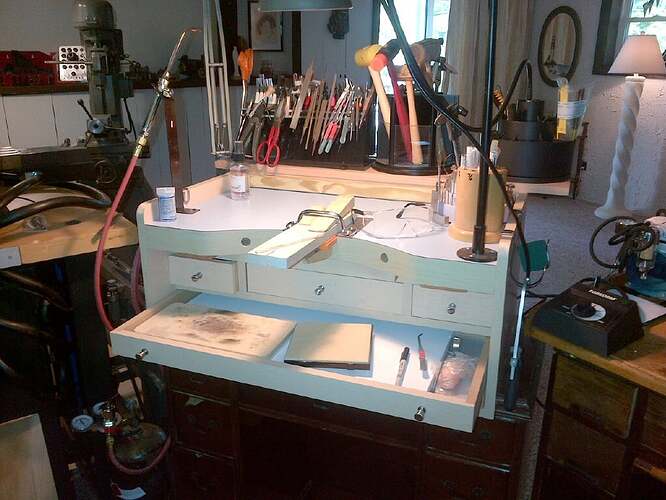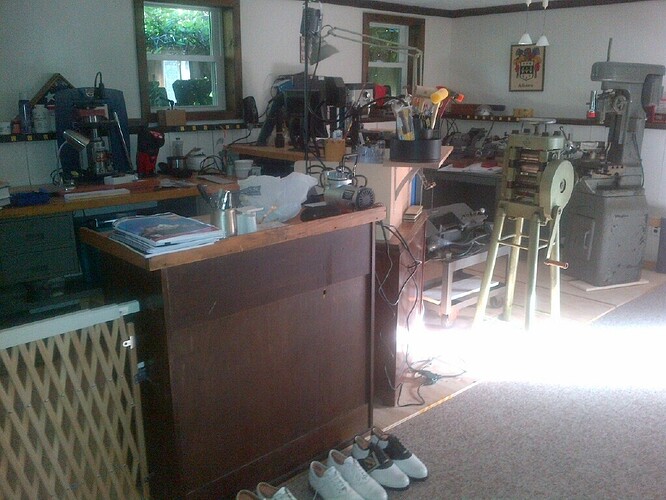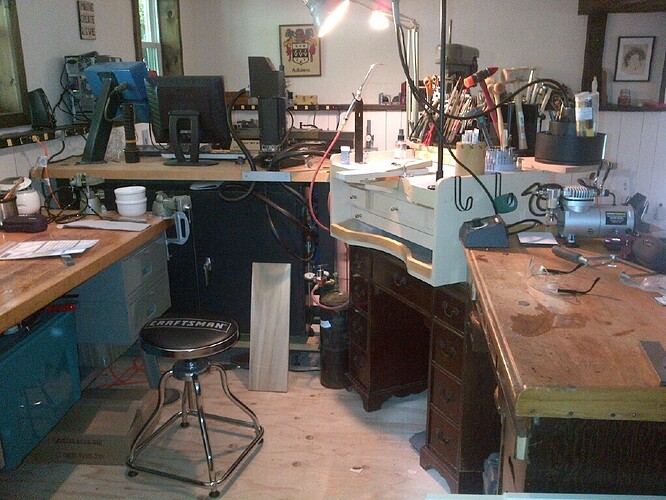This is my little slice of heaven (or corner of incompetence, as the case may be). I put a plywood “floor” on indoor outdoor carpeting in an area of my house that we really don’t use anymore.
The Linley is no longer, sold to a regretfully cost concious DARPA group that builds robots. The lathe is a little Craftsman 6" in as new condition. The mill is a Servo Mill, also in as new condition, made in the early 90’s and realy man on the moon stuff. The watchmakers bench turned out to be way too flimsy for bangin’ metal. Now it’s more for layout, storage and a reminder to think purchases out before making them. The 1/2 jewelers bench is solid, and screwed completely into the little sewing machine table, essentially making one cohesive unit. It simply does not move, and is actually way more solid than the industrial bench on the left of it in the second photo. It was my pretty much my first jeweleresque purchase.
Since I’ve added several GRS stations, but I still prefer the Japanese bench pin method. It’s easy to make a “purpouseful” bench pin from different woods (for instance, to support a longer piece) and it’s easy to replace when it wears. There is no place in life I would rather be…
This is my little slice of heaven (or corner of incompetence, as the case may be). I put a plywood “floor” on indoor outdoor carpeting in an area of my house that we really don’t use anymore.
The Linley is no longer, sold to a regretfully cost concious DARPA group that builds robots. The lathe is a little Craftsman 6" in as new condition. The mill is a Servo Mill, also in as new condition, made in the early 90’s and realy man on the moon stuff. The watchmakers bench turned out to be way too flimsy for bangin’ metal. Now it’s more for layout, storage and a reminder to think purchases out before making them. The 1/2 jewelers bench is solid, and screwed completely into the little sewing machine table, essentially making one cohesive unit. It simply does not move, and is actually way more solid than the industrial bench on the left of it in the second photo. It was my pretty much my first jeweleresque purchase.
Since I’ve added several GRS stations, but I still prefer the Japanese bench pin method. It’s easy to make a “purpouseful” bench pin from different woods (for instance, to support a longer piece) and it’s easy to replace when it wears. There is no place in life I would rather be…
This is my little slice of heaven (or corner of incompetence, as the case may be). I put a plywood “floor” on indoor outdoor carpeting in an area of my house that we really don’t use anymore.
The Linley is no longer, sold to a regretfully cost concious DARPA group that builds robots. The lathe is a little Craftsman 6" in as new condition. The mill is a Servo Mill, also in as new condition, made in the early 90’s and realy man on the moon stuff. The watchmakers bench turned out to be way too flimsy for bangin’ metal. Now it’s more for layout, storage and a reminder to think purchases out before making them. The 1/2 jewelers bench is solid, and screwed completely into the little sewing machine table, essentially making one cohesive unit. It simply does not move, and is actually way more solid than the industrial bench on the left of it in the second photo. It was my pretty much my first jeweleresque purchase.
Since I’ve added several GRS stations, but I still prefer the Japanese bench pin method. It’s easy to make a “purpouseful” bench pin from different woods (for instance, to support a longer piece) and it’s easy to replace when it wears. There is no place in life I would rather be…


